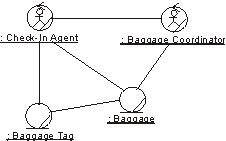Guidelines: Collaboration Diagram in the Business Object Model
Collaboration Diagram |
A collaboration diagram
describes a pattern of interaction among objects; it shows the objects participating in
the interaction by their links to each other and the messages that they send to each other. |
Topics
Team-Collaboration Diagram 
A team-collaboration diagram shows which business workers must interact, and which business entities must be accessed to perform the workflow of a business use case. In other words, a team-collaboration diagram contains business workers, business entities, and the links between them. If it makes the diagram more informative, you can also include business actors that are related to the business workers.
In a team-collaboration diagram, messages, and message sequence numbers are excluded. You cannot show how the control of behavior is passed between the workers. Often, but not always, this is a sufficient level of detail to specify a business use case’s internal behavior. If the level of detail is not sufficient, develop a sequence diagram, or a work-collaboration diagram of the critical part.

A team-collaboration diagram for the use case Individual Check-in.
Work-Collaboration Diagram 
A work-collaboration diagram is semantically identical to a sequence diagram but focuses on the objects, while the latter focuses on the interactions. In contrast to a team-collaboration diagram (which tells in general which objects are involved in the execution of a use case and their links, but without specifying messages), the work-collaboration diagram should present the subset of objects relevant to the affected working sequence, including their links, messages, and message sequences.
![]()